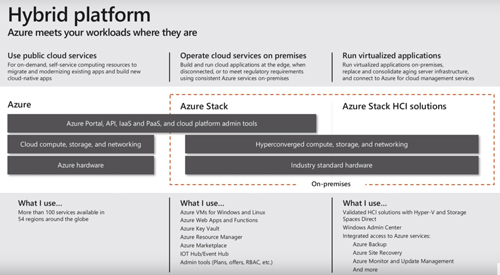News
Azure Stack HCI Product Unveiled for Hybrid Workloads
Microsoft on Tuesday announced a new product in its Azure Stack line that adds hyperconverged infrastructure (HCI) capabilities to its "Azure in a box" solution.
Azure Stack HCI is yet another Azure Stack product offered by Microsoft and its hardware partners. The HCI product is aimed more toward organizations wanting to run applications on traditional virtual machine infrastructure, according to an announcement by Julia White, corporate vice president of Microsoft Azure:
We are bringing our existing HCI technology into the Azure Stack family for customers to run virtualized applications on-premises with direct access to Azure management services such as backup and disaster recovery. Azure Stack HCI solutions feature the same software-defined compute, storage, and networking technology as the existing Azure Stack, and include simplified cloud access via the Azure hybrid services in Windows Admin Center.
HCI is typically described as a Windows Server capability that was kicked off with Windows Server 2016. It allows organizations to run storage, compute and networking operations on a single server in a cluster. This arrangement also lets organizations use off-the-shelf, lower-cost components, including SATA and NVMe solid-state drives and persistent memory silicon, plus the Storage Spaces software-defined storage pools capability of Windows Server.
In order to use Azure Stack HCI, organizations need to purchase "Microsoft-validated hardware" from Microsoft's partners. There are currently 15 partners with the HCI hardware offerings. Organizations also need use the Windows Server 2019 Datacenter edition.
The browser-based Windows Admin Center is the main management tool for Azure Stack HCI. It'll hook into other Azure tools, such as Azure Monitor, Azure Security Center, Azure Update Management and Azure Site Recovery, among others. Microsoft has been adding capabilities to Windows Admin Center over the years and recently announced a preview of version 1903.
A Microsoft video on Azure Stack HCI depicted it as a way for organizations to upgrade their infrastructures at a lower cost. Jeff Woolsey, a principal program manager at Microsoft for Windows Server, noted that organizations have been holding onto their servers longer, for 7.5 years, eight years and even 10 years. However, with 10-year-old servers, they don't have things like Secure Boot, Unified Extensible Firmware Interface (UEFI) and Trusted Platform Modules (TPMs) to take advantage of better security.
Some applications just need to run in on-premises environments and don't require many of Microsoft's platform-as-a-service (PaaS) offerings, which is another reason Microsoft came up with the Azure Stack HCI product, according to Vijay Tewari, director of Azure Stack, in the video. Organizations can also use Azure Stack HCI to avoid latency issues with their hosted applications, he added.
In the video, the following "hybrid" overview slide was shown:
 [Click on image for larger view.] Microsoft's concept of when to use Azure Stack vs. Azure Stack HCI. (Source: Microsoft video)
[Click on image for larger view.] Microsoft's concept of when to use Azure Stack vs. Azure Stack HCI. (Source: Microsoft video)
Azure Stack HCI users are conceived as being more interested hosting their own applications and just tapping Microsoft's cloud services for things like Azure Backup, Azure Site Recovery and Azure Monitor, according to the slide.
If an organization wanted to use the infrastructure-as-a-service (IaaS) and Paas solutions of Azure in their hybrid environments, then Microsoft's Azure Stack product is the option to use. Azure Stack is a collection of Microsoft's Azure datacenter technologies delivered in an appliance for organizations to deploy on their own infrastructures, or it's offered as a managed service by Microsoft's Cloud Solution Provider (CSP) partners.
Users of Azure Stack HCI don't have a quick upgrade path to Azure Stack, though. They would have to move their data to Azure Stack to make the switch.
About the Author
Kurt Mackie is senior news producer for 1105 Media's Converge360 group.